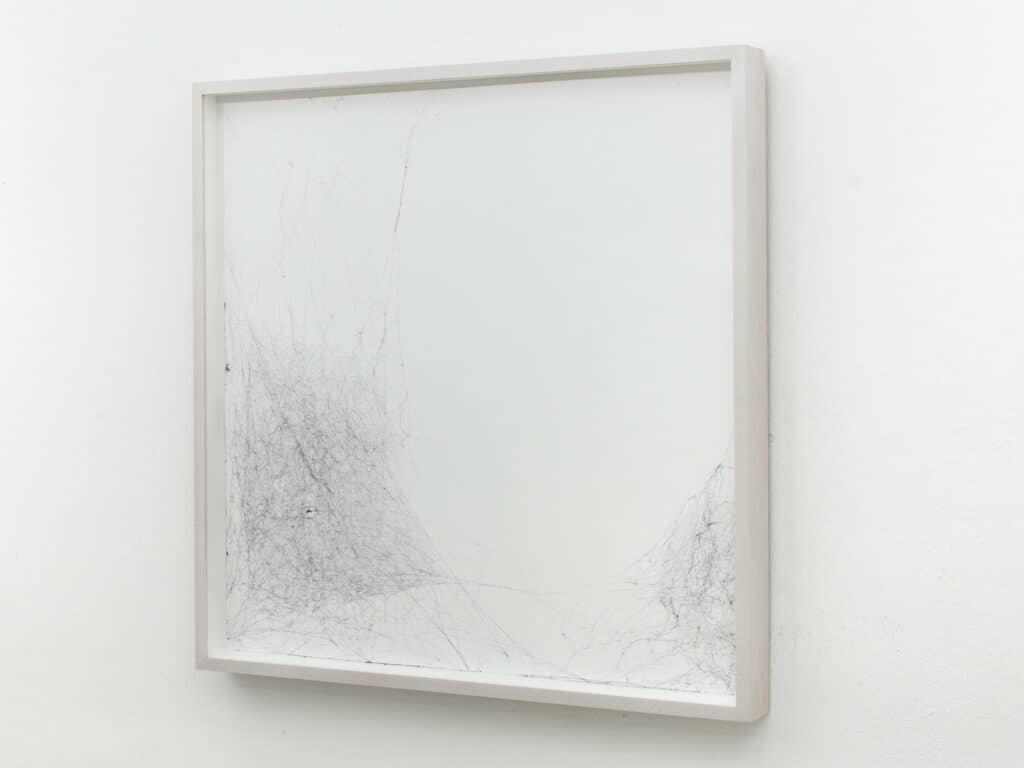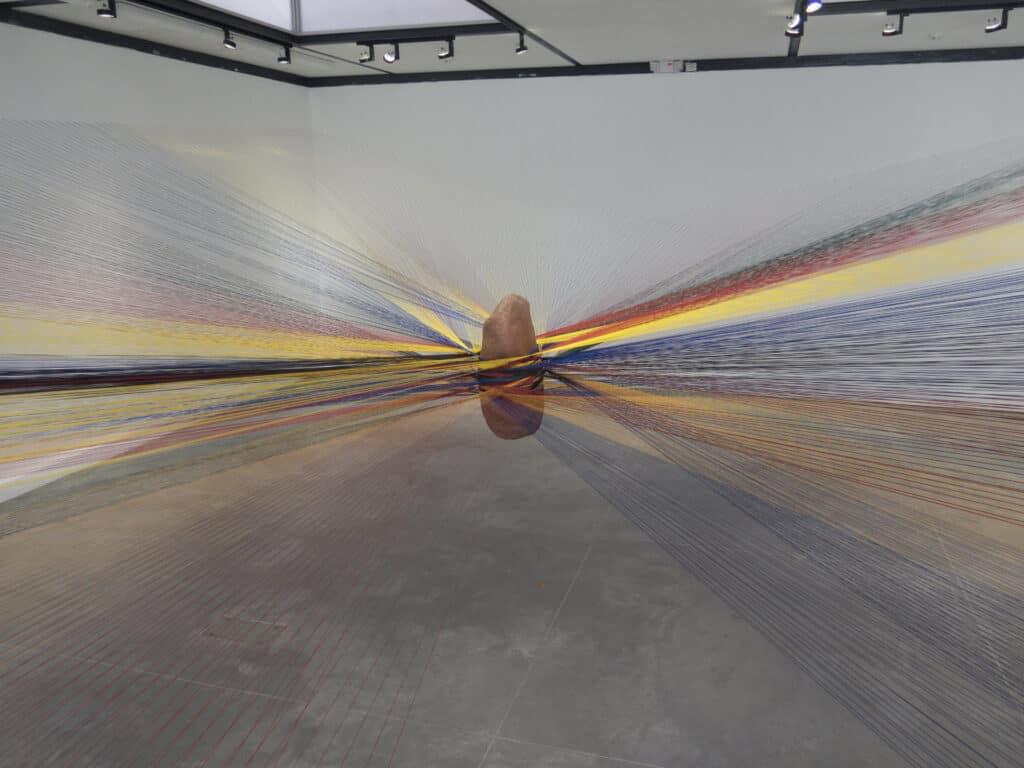Articles and Features
Living a Harmonious Contradiction.
A Journey into Bio and Eco-Art
Anthony Dexter Giannelli
Nature’s Invasion of the White Cube
Entering a white cube, often windowless gallery space can feel like a safe haven, an artificial capsule that removes art and its audience from the dangers, influences, context, and stimuli of the outside world. Most often the spaces that house contemporary artworks are located in major urban centres, where this holy white cube is further surrounded by a broader man-made world in a bubble of artificiality, the furthest removed from the infinite uncontrollable variables of the natural world. To preserve artworks we control this internal environment down to the minutia: humidity levels, temperature, distance from human bodies, and from the aging effects of UV from sunlight.
When these meticulously maintained spaces are infiltrated by free-flowing, moving, growing biological or ecological elements the contradictory forces create an otherworldly experience: it feels like an oxymoron, unnatural and dystopian. This past spring environmentalist sage and giant of contemporary installation art, Olafur Eliasson opened Life, a surreal invasion of aquatic microspherical biomes engulfing the white cube gallery spaces of the Foundation Beyeler in Basel, Switzerland. As guests to this habitat resembling somewhat of a primordial oozing pond, visitors traverse across pierlike walkways as aquatic plants, bacterium, micro-animals, ducks, and everything in between chart along with their cycles of life with little regard to the carefully curated and protected space that was the gallery was just months ago and will return to in some short months after the exhibition is over.
Eliasson is leading a continued effort by artists across mediums, backgrounds, and concentrations to address the disconnect between our carefully cultivated artificial experiences and the glorious uncontrollability of the natural world. More artists call to question how art like every other element of human society needs to respond to human-caused damage, the climate disaster, and the current age of ecological collapse, which we find ourselves in. Explorations and reflections onto the severance of the world of man-made objects from the biological, ecological world have been growing since the 1960s and are finding their imperative incorporation across contemporary art, in search of that magical line where these two worlds can exist in harmonious contradiction.
Exploring Life and its Relationships
Exploring similar concepts and with areas of intercept, Bio and Eco-Art take blend elements of art, biology, environmentalism with different points of departure: the use of specifically living biological elements when it comes to Bio Art, and the aim to shine a light on the relationships between living things as for Eco-Art, often with a larger focus on preservation, understanding, and appreciation of the earth’s ecology. Both of these forms exist under a wider family of environmental art, grouped together and even overlapping at times with their cousin, land art. However, while land art lives out in the open and is subject to erosion, weathering, and other natural phenomena, Bio and Eco artworks are often placed within the normal context for viewing contemporary art, in institutional white cube spaces.
Their presence in this contrasting space is what joins Bio and Eco-Art together; often provocative and introspective pieces are laden with reflection on our individual and collective inner humanity and our relationship towards the outside, natural world. Whether in individual, even microscopic works, or through expansive installation-based mega-works, the presence of the natural world’s infinite uncontrollable qualities within our obsessively, cultivated artificial environments presents itself as a glitch in the matrix. But simply producing works taking awe of the beauty of the natural world is in no way new to art, in fact, it’s among the very first forms of creative expression that we’ve been able to view in humanity, from the visceral cave paintings of the Chauvet Cave in France to the grandiose landscape oil on canvases. So what exactly allows these new forms of Bio and Eco-Art to evolve to a new stage beyond awe-inspiring representation?

Tangled Webs of Meaning
The first movers in this new field of contemporary art found themselves representing often contradictory forces. Together with those artists who wanted to display the beauty and appreciation of biology, Bio art also featured extremely controversial artists who instead chose to open the eyes of the general public to the ways in which humanity can (for better or for worse) shape and bend biology to our whim in the present and how this can expand in the near future. Topics such as biohacking – as in Eduardo Kac’s work altering the genesis of some typical laboratory common animals to glow in the dark – were extremely provocative in making us question how far is too far when manipulating life forms for aesthetics or for artistic purposes. This could even be brought to the extreme when artists, Sun Yuan and Peng Yu’s “Dogs That Cannot Touch Each Other” involved live animals in dangerous situations and opened with so much outcry from the general public that it was removed from the Guggenheim.
Though these works achieved the goal of making us question our ethical involvement and impact on animal life, they were largely refuted within the art world. While mistreatment in areas such as industrial farming or habitat destruction occurs on a daily basis out of sight, the artwork was merely in front of our faces on the glorified pedestal in a prestigious art institution. Today, most Bio art chooses to remove the presence of animals in the presentation of their works and yet proves to be just as powerful. Take for example the spider works created by Tomas Saraceno by dying spider silks and letting the arachnid architects build their alluring, unconstrained woven structures undisturbed to then be documented and displayed in the typical white cube gallery space.
While taking inspiration from forms of life, Eco-Art focuses much more on the relationships, causes, and effects that exist within the web of life, without necessarily incorporating live elements themselves. Demonstrating the specific grotesque perversion that can occur in humanity’s interaction with these relationships, Japanese artist Tetsumi Kudo sheds a light on the perseverance of life in spite of humanity. Having lived through the nuclear travesties from heavy bombing by the United States on Japan in World War II, Kudo’s works show what we would imagine reentering ecological disaster sites like Chrynoble: eventually, the ecosphere does rebuild, but not exactly the way it was before. Kudo explores topics surrounding the loss and persistence of life through sculptural amalgamations of bio reminiscent forms. Tetsumi’s foreboding creations are currently being met with new appreciation as we’re increasingly expanding our view of these ecological disasters. Instead of seeing them as isolated events, they are rather symptoms of a single problem, our disconnection and perversion of nature resulting in irreversible damage in this new era of the Anthropocene.
While artists like Kudo use Eco-Art to display ecology and life’s perseverance in spite of humanity, others such as 80’s pioneer Venezuelan artist Milton Beccera use the deceptively “human” language of geometry to show humanity’s connection, dependence, and the possibility of harmony within the ecological world. Through connection with indigenous peoples of the biodiverse Amazon and South American forests, Becerra uses influence from their cosmology and manipulation of natural materials to bring intricately laced fibres to surround and suspend geological bodies within the canvas or within the white cube. Grand installation works including Saraceno’s air plant inhabited small biodomes connected by netting across museum halls, also force us to recall the interconnectedness that webs our small branch and all branches on the tree of life together.

Life’s Lessons
Although many of his most famous and well-known pieces are overtly political and attention-grabbing climate change alarms, Eliasson’s practice does not solely produce works with the overt, main concepts being a face-hitting reference to the natural world. Take, for example, Reality Projector: an immersive experience in a colossal industrially reminiscent, gutted theatre space in Los Angeles. Through a rarely repeating combination of sound and light, the work gave each viewer a unique experience and real effect on the piece through their physical presence. Viewers played the two roles that we all play in any space – natural or artificial – simultaneously invisible actors and active audience members. What ties his works together is rather a focus on space, light and the present. Whether human-made spaces or the rare untouched virgin natural environments, we all have an effect on any space we inhabit as members of humanity.

Artists working with Bio and Eco-Art call attention to the fact that we are part of the chaos that is life, biology, and the ecosystem; we are the mere actors on the stage of the natural world. When it seems like humanity and nature work in opposition, no matter how hard we try to mould it or control it, nature finds a way to remind us that we are guests in its space. It is our home to protect, love, relish, and play our small but important part in the everlasting production within the theatre of life.
Relevant sources to learn more
Environmental Art: Changing Our Habits Or Just Illustrating What We Already Know?

